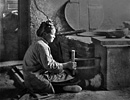|
Photo Exhibition China : Beijing to Lhasa, from Evariste Huc (1813-1860) until now
Section 6 - Gansu Province
Discover the evolution of this area during history.
EXTRACT OF TEXT FROM THE DESCRIPTIVE PANEL :
Identity card
Name : Gansu province, Gansu Sheng in chinese .
Surface : 4 540 000 km².
Capital : Lanzhou, City and prefecture, 3 100 000 inhabitants (2004), 1 500 m altitude.
Population : 25 000 000 inhabitants (2004) et 57 hab./km².
Principal ethnos groups : Han (92%), Ouïgour, Zhuang, Hui, Tibétain, Mongol, Kazak, Tu, Salar, Dongxiang.
Writing and languages : mandarin, arab and tibetan.
Climate : continental cold and dry.
Winter average (Lanzhou) : - 12 °C
Summer average (Lanzhou) : + 29 °C
Winter record (Lanzhou) : - 21 °C
Summer record (Lanzhou) : + 36 °C
Number of Raining days (Lanzhou) : 71 days/year.
With the passage of Evariste Huc
Gansu, an area hinge and a door of entry of the Chinese Empire
After having crossed the Large Wall, in Zhongwei, Evariste Huc faces the terrible desert of Tengger and crosses in its width the corridor of Gansu. This narrow corridor where the Large Wall ends is wedged between Tibet and Mongolia. It marks the border between the Chinese Empire and the world of the steppes. Gansu was in the past an important strategic territory and a feature of union between the Chinese Empire and the Occident. The "barbarians" engulfed themselves by this door of entry in the celestial Empire and the caravans of the Road of silk benefitted from this axis to export their goods of Asia towards the Occident...

|
|
Thematic canvas :
Gansu Province
Discover the old and comptemporaine history of this China area.
|

|
|
Millet and corn cultures in the green corridor of Gansu
:
China is the first world corn producer since the beginning of the years 1980. Indeed, its production is in strong increase since 1961. It passed from 14,3 million tons to 116 million tons in 2007. This rise of the production is explained in particular by the very important improvement of the output to the hectare which was multiplied by six in 40 years. Paradoxically, cultivable surfaces decrease because of the continuous increase in the population, erosion, and the extreme degradation of the grounds
. . .
|

|
|
Hui stallholder in the town of Yongdeng
:
"The ability to be able to circulate freely and without obstacles in all the provinces is a to some extent essential need for these populations, continuously launched in the operations of large and the small business. It is conceived that the least embarrassment brought to their journey would slow down this commercial rise which is to some extent the life and the heart of this vast empire."
Évariste HUC — Chinese Empire .
|

|
|
Beginning of the XXth century photographs (Missions Étrangères de Paris) :
"All the inhabitants of the Celestial Empire, without exception, have a remarkable aptitude for the culinary preparations. If one needs a cook, it is the thing easiest of the world to get... What astonishes more, it is the excessive simplicity of their means; only one iron pot is enough for them to carry out the most difficult combinations promptly."
Évariste HUC — Chinese Empire .
|

|
|
Mosque in the fog close to the town of Yongden :
In the past, the mode of the "religious community" or jiaofang was exerted by Hui community. It combined religion and economy. Thus, a mosque was to be built at each place inhabited by an active group of ten to a few hundreds families today. The Imam of the mosque (ahung, in Chinese) managed the religious businesses of the community, regulated the aspects of the life of its members and collected the religious contributions and other taxes. The various religious communities opened out independently ...
|
And 5 other photographs accompagnied by captions...
|

|

|

|
|
